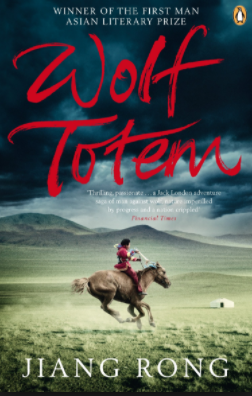|
|
In 1969, a young Chinese intellectual from Beijing, Jiang Rong, answered Chairman Mao’s call for city dwellers to go “up to the mountains and down to the countryside,” and travelled to one of China’s most “primitive” places, north-central Inner Mongolia. The city dwellers, some going voluntarily, some forced, were to learn from the rural workers. Jiang Rong lived and worked among the nomadic Mongolian herdsmen working as a shepherd for 11 years. This was during the Cultural Revolution when the “four olds” (old thought, old culture, old customs and old practices) were being pushed aside by the Red Guards, especially among the “backward” members of superstitious and conservative rural societies. He found himself more and more identifying with the sustaining life style of the herdsmen and especially their veneration of wolves and their relationship with the land.
So the novel, Wolf Totem, is semi-autobiographical with the setting and characters being fictionalized. The central character, Chen Zhen and his classmate, Yang Ke are the Beijing students who take up life in the grassland, living with the Mongols in yurts and learning to herd sheep. They come to understand the fierce pride the herdsmen have for their ancestors of the twelfth and thirteenth centuries, Genghis Khan and his warriors. The Mongols’ successful military strategies were learned from the tactics the wolves employed in bringing down herds of sheep, gazelles or horses. The Mongols compared themselves to the fierce, shrewd wolves and the Han Chinese to fearful sheep who only survive by foraging for grass. |
|
Crossing the grassland with the Mongols on their nomadic journeys repeated annually, the students come to respect the wolf, which represents both life and death. Eventually Chen adopts a wolf cub, with tragic consequences. As the novel unfolds more and more examples of the symbiotic bond between the wolves and the herders are presented. It becomes clear that their dominion over the grassland is slowly slipping away as the pressure from the Han Chinese for more and more farmland inexorably mounts. The outcome is sadly predictable.
It is a novel of amazing breadth, with the stars being the Mongols and the wolves. Some of our group found it a difficult novel to read, as it was long, drawn out and graphic in its portrayal of the struggles between the wolves and their prey. Others thought the dialogue frequently felt stilted. Some commented that the panorama of the grassland setting and its description along with the inclusion of details of its other inhabitants like swans, marmots, prairie dogs and the sheep and horses offset that disappointment. It offers penetrating insight into the life and beliefs of a culture thousands of years old that has sustained itself through wise stewardship of the environment. The story has been made into a film by French filmmaker Jean Jacques Annaud, and while remaining true to the grandeur of the setting, it takes liberties with the plot, introducing a romantic interest. The book was published in 2004 receiving unprecedented attention in China. It was the winner of the First Man Asian Literary Prize in 2007. For those of us who finished the novel, (translated by Howard Goldblatt), it was truly a good read.
Submitted by Leslie Muri Book Group 1 |
|
|
|
|





